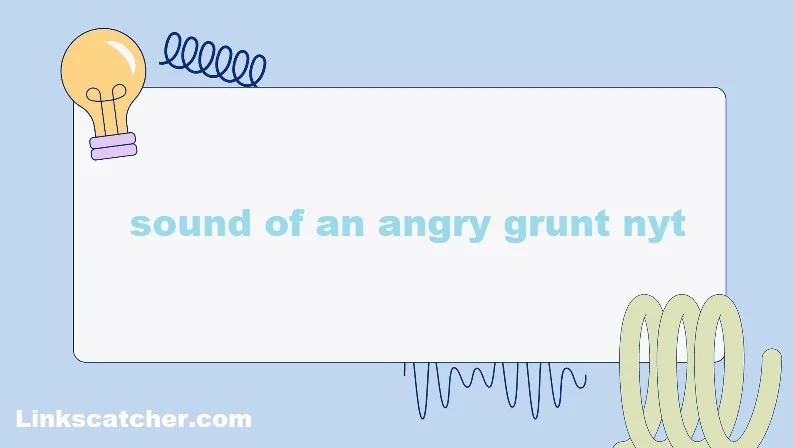
Ever been in a situation where you heard a sound of an angry grunt nyt and instantly felt the tension in the room spike? It’s a universal sound that transcends languages and cultures, signifying frustration, annoyance, or outright anger. But what makes this sound so powerful? Let’s dive into the intriguing world of the angry grunt, unravel its complexities, and understand its profound impact on human communication.
The Nature of Sound of an Angry Grunt Nyt
Defining the Grunt
An angry grunt is more than just a simple noise. It’s a guttural sound produced when someone is experiencing strong emotions, typically anger or frustration. Unlike words, grunts convey raw, unfiltered emotion, often more effectively than spoken language.
Common Triggers
Several situations can trigger an sound of an angry grunt nyt. These can range from minor irritations, like stubbing a toe, to significant frustrations, such as missing an important deadline. Understanding these triggers can help in managing one’s response to the grunt and the underlying emotion.
Psychological Implications
Anger and Expression
Anger is a natural human emotion, but its expression varies widely. The sound of an angry grunt nyt is a form of non-verbal expression that can indicate suppressed frustration. It’s a way for individuals to release tension without resorting to more aggressive actions.
The Role of Context
The context in which an angry grunt occurs is crucial. A grunt in a competitive sports match might be seen as a normal part of the game, while the same sound in a quiet office could be alarming. Context shapes our perception and reaction to these vocal expressions.
The Science behind the Sound
Vocal Cord Mechanics
The production of a grunt involves the vocal cords and the breath. When a person grunts, the vocal cords tighten, and a burst of air is expelled from the lungs, creating the characteristic sound. This physical mechanism is quite different from regular speech.
Acoustic Properties
Acoustically, an sound of an angry grunt nyt has a distinct profile. It typically involves lower frequencies and a rapid onset, making it easily recognizable. These properties allow it to cut through background noise and grab attention immediately.
Cultural Perspectives

Western Views
In Western cultures, angry grunts are often seen as impolite or unprofessional. They’re usually associated with a loss of control, something that is generally frowned upon in formal settings.
Eastern Views
In many Eastern cultures, there are more acceptances of non-verbal expressions of emotion, including sound of an angry grunt nyt. These sounds are often understood as a natural part of human expression and are less likely to be stigmatized.
Case Studies and Examples
Famous Angry Grunts in Media
Media has given us some iconic sound of an angry grunt nyt. Think of characters like Homer Simpson, whose grunts of frustration have become a signature part of his character. These grunts help to convey his emotions instantly and effectively.
Real-Life Instances
In real life, angry grunts are common in high-stress environments. Consider a busy kitchen during dinner rush or a construction site under a tight deadline. In these settings, grunts are a way for individuals to vent their frustration quickly.
Managing and Responding to Angry Grunts
Personal Strategies
When you encounter an angry grunt, it’s essential to stay calm. Techniques like deep breathing, taking a short break, or addressing the root cause of frustration can help manage the situation effectively.
Professional Approaches
In professional settings, it’s crucial to maintain a composed demeanor. Acknowledging the grunt without escalating the situation, offering support, or redirecting the focus to problem-solving can be effective strategies.
The Role of Angry Grunts in Communication
Nonverbal Communication
Angry grunts play a significant role in nonverbal communication. They convey emotions that words might fail to express, adding a layer of depth to human interactions.
Impact on Relationships
Frequent sound of an angry grunt nyt can strain relationships, indicating unresolved tension or ongoing frustration. Addressing the underlying issues and fostering open communication can mitigate these effects.
Conclusion
The sound of an angry grunt nyt is a powerful sound, rich with emotion and meaning. By understanding its nuances, we can better navigate our interactions and manage our responses. So next time you hear that unmistakable grunt, take a moment to consider what’s really being communicated.
Faqs about Sound of an Angry Grunt Nyt
Q: Can an angry grunt be a sign of deeper issues?
A: Yes, frequent angry grunts can indicate underlying frustration or unresolved issues that need to be addressed.
Q: Are angry grunts more common in certain cultures?
A: While the expression of anger varies, the angry grunt is a universal phenomenon, though its interpretation can differ across cultures.
Q: How can I respond to an angry grunt in a professional setting?
A: Stay calm, acknowledge the emotion, and focus on problem-solving rather than reacting to the grunt itself.
Q: Can managing stress reduce the frequency of angry grunts?
A: Absolutely. Effective stress management techniques can help reduce the triggers that lead to angry grunts.
Q: Are there positive ways to express frustration without grunting?
A: Yes, techniques such as verbal communication, physical exercise, and mindfulness practices can be healthier alternatives.